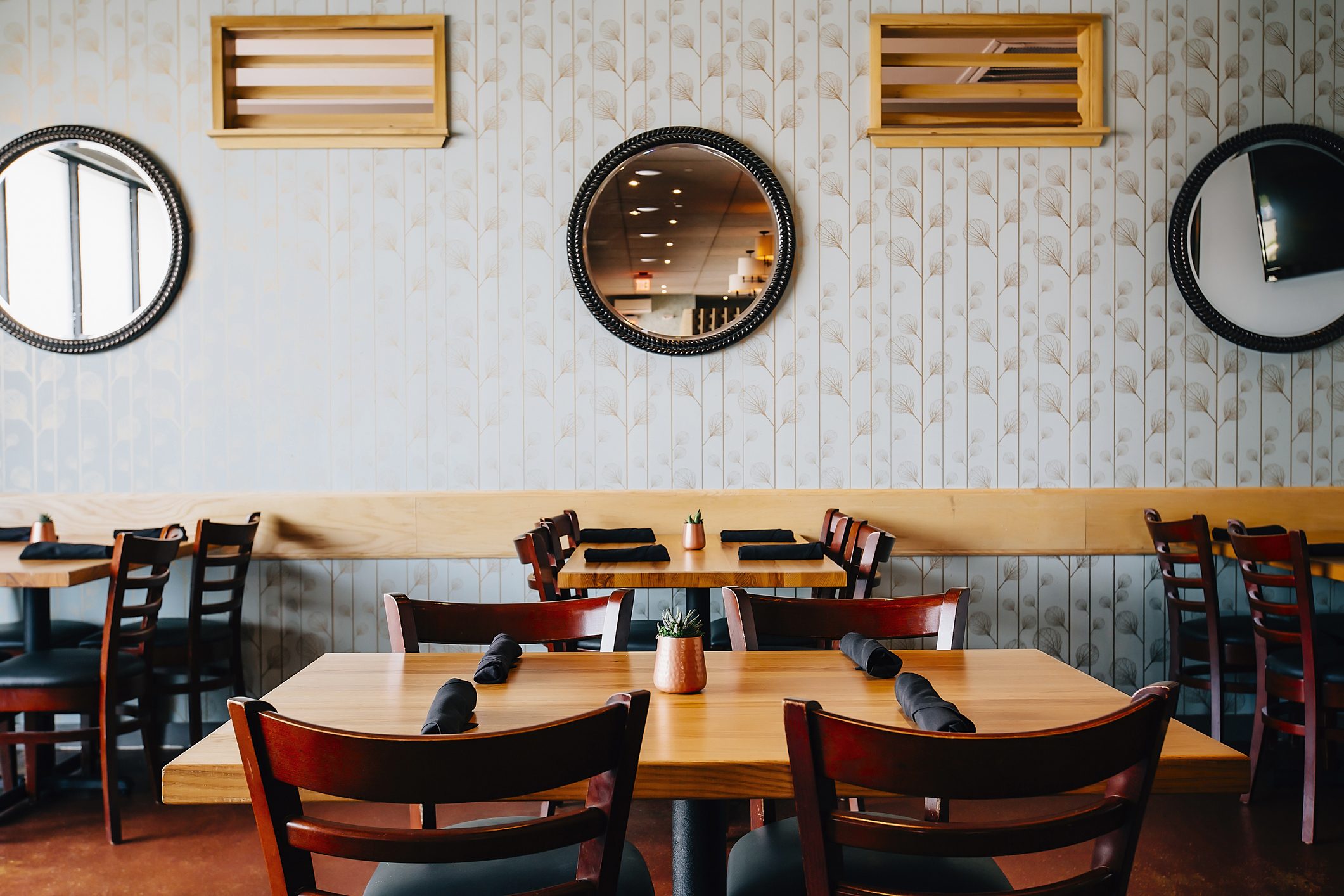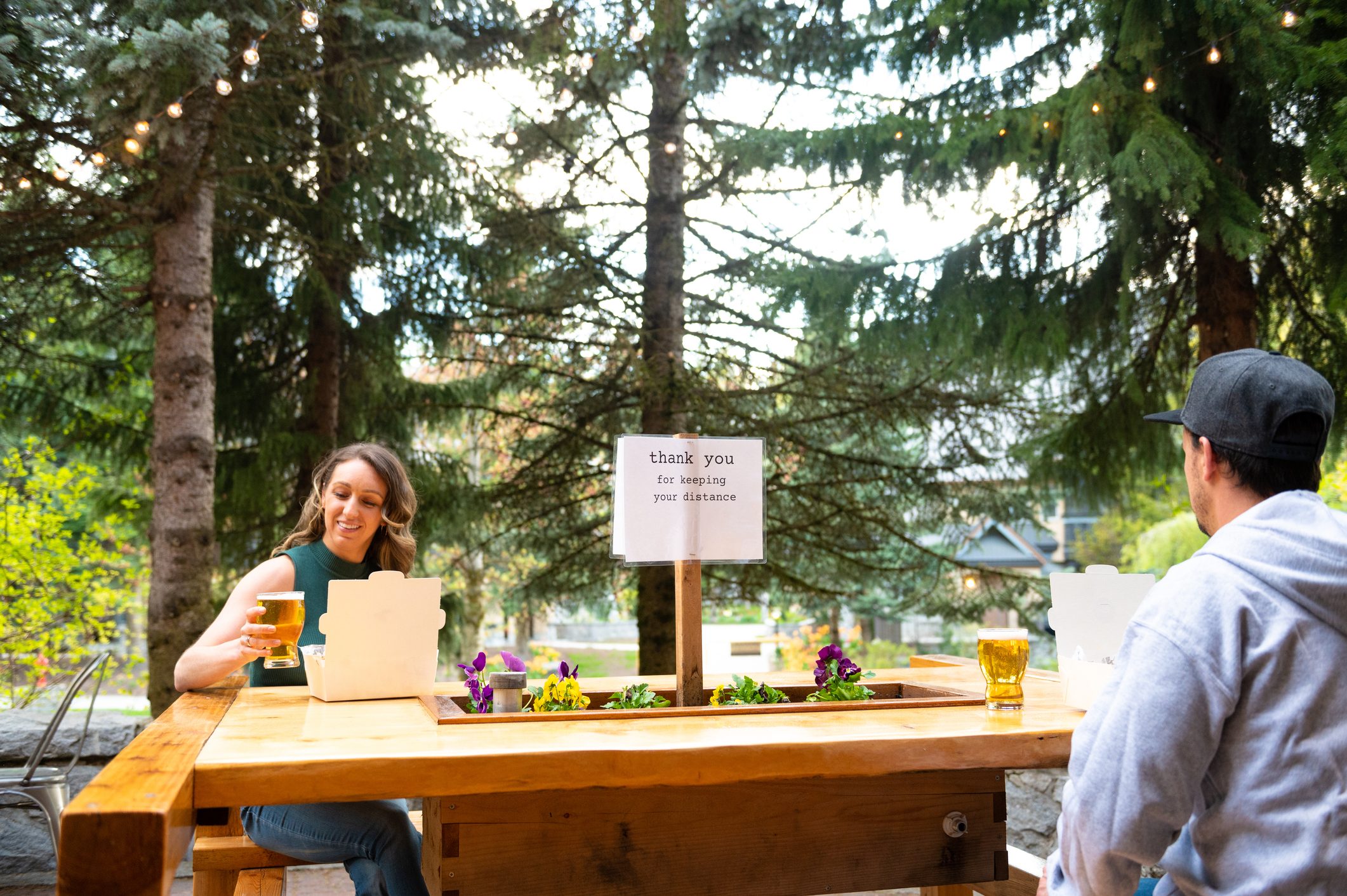by Karla Walsh
Health experts share their tips for dining out safely at restaurants during Covid-19 as they begin to reopen for indoor and outdoor dining.
States and reopening restaurants
Since we’re likely still months away from a Covid-19 vaccine, all 50 states—fearing an even larger economic hit—have decided to slowly start reopening. As of mid-May, many states are allowing dining in with some restrictions, such as 25 to 50 percent capacity. Others are sticking with carryout or delivery only through June, including, Colorado, Delaware, Hawaii, Illinois, Kentucky, Maryland, Massachusetts, Michigan, Minnesota, New Hampshire (outdoor dining only), New Jersey, New Mexico, New York, Pennsylvania, South Carolina (outdoor dining only), Washington, and Vermont.
As restaurants begin to reopen their doors for dining in, the danger lies not in the food (as long as normal food safety procedures are followed). The risk is being within cough’s reach of other people who may not know they’re infected with the virus. An April 2020 study in the New England Journal of Medicine (NEJM) bears out that as many as half of those who contract Covid-19 are completely asymptomatic, meaning they would likely go about daily life with fewer precautions then someone who has a fever, cough, shortness of breath and subsequently tested positive for the virus. (More on the importance of coronavirus testing on containment of the disease here.)

Covid-19 and dining out
There’s no definitive source that sets the rules for restaurants during pandemics, but the Centers for Disease Control and Prevention (CDC), Food & Drug Administration (FDA), and National Restaurant Association (NRA) have all released blueprints and suggestions for businesses so they can reopen as safely as possible.
While your safest bet is to cook at home, order from a place that delivers, or coordinate curbside carry out, it’s totally understandable that after more than two months of sheltering in place, you’re ready to put down the apron and eat a nice meal at a restaurant. To help you navigate the new dining out landscape in the least risky style, we spoke with a doctor, food safety expert, and a CDC spokesperson for tips on how to dine out safely.
Wash your hands
What mom said over and over again when you were growing upholds true now more than ever. Wash your hands early and often. “Hand hygiene is always important when talking about preparing or eating food. It’s a good idea to wash your hands before you eat. If you don’t have access to a sink—if you’ve just ordered from a food truck, for example—use hand sanitizer,” says Natalie Seymour, a food safety extension associate at North Carolina State University in Raleigh, North Carolina. Seymour is currently helping to prepare and train restaurants in her state as they prepare to reopen dining areas. “Many businesses are being required to supply it, but keeping a small bottle on hand at all times is a good idea nowadays.” (Need more convincing to suds up? Here are 7 things that can happen if you don’t wash your hands.)
Pay attention to the restaurant’s safety strategies
The spread of Covid-19 is much more likely in concentrated groups of people who are close to each other, Seymour explains, “so spacing out people in a dining area is really important to limiting the spread.”
That being said, the CDC has rated the relative risk levels of restaurants accordingly:
-
Lowest risk restaurants: These have a drive-through, delivery, take-out, and/or curbside pick up—but no on-site dining.
-
Medium risk restaurants: Places that have a drive-through, delivery, take-out, and/or curbside pick up, but also offer outdoor dining with seating limited to tables that are spaced six or more feet apart.
-
Medium-high risk: This equals dining inside and out with seating limited to tables spaced six or more feet apart.
-
Highest risk: Indoor and outdoor dining at tables that are less than six feet apart.
“If the restaurant you want to go to doesn’t seem like it’s set up for distancing, then I’d recommend ordering takeout and enjoying the food someplace else. Restaurants should be reorganizing dining rooms, limiting the number of chairs at bars, and using ground markers for lines and waiting areas,” Seymour says.
That doesn’t guarantee what other guests will do or if they will follow the regulations, though. So, if anything about the fellow diner’s behavior, the dining room setup or the staff activity feels “off,” considering ordering your meal to go. (By the way, the latest science says that we cannot acquire the virus through food.)
Eat at non-peak times
Consider a late lunch or early bird dinner to avoid the rush. “Many states and counties now limit indoor seating to 25 percent to allow for social distancing,” says Eudene Harry, MD, a board-certified emergency medicine doctor, medical lifestyle expert, and the medical director for Oasis Wellness and Rejuvenation Center in Orlando. “As a patron, it may be best for you to dine during ‘off-hours’ or at times when it is easier for these guidelines to be met.”

Dine outside when possible
As we mentioned, Covid-19 spreads mainly through respiratory droplets. The jury is still out whether the virus can live in outdoor air or travel through ventilation systems like other infectious viruses, such as tuberculosis or measles. (In an April 2020 article in the NEJM, experts believe may live up to three hours in the air. Until we know more, the higher the percentage of fresh air, the better.
“Some research shows that humidity between 40 and 60 percent may help to reduce the infection rate of viruses,” Dr. Harry says. “Many indoor spaces do not have humidity control. This is theoretical for this particular virus, as it has not been specifically studied,” but if the weather is nice and you don’t have seasonal allergies, it can be wise to ask for an alfresco table.
“Staying outside is a great way to help mitigate risk across the board since there is often more space to spread out and the air isn’t being recirculated. But it isn’t failsafe, so it is still important to follow distancing guidelines and proper hygiene habits,” Seymour says.
Wear a face covering
Both the NRA and CDC recommend requiring the use of cloth face coverings for all staff, especially when it’s impossible to keep six or more feet apart (say, when a server is delivering a plate to a table). In restaurants, face coverings, like a mask, are seen as more of a protective measure for the diners than the server wearing them—so it’s an act of care for diners.
In return, “a lot of states are asking people to wear masks while they are out as a precaution for the staff and other diners. If you’re wearing a mask or a cloth face covering while going out to eat, you could leave it on right up to when the food is served. Then, remove the mask without touching the inside, and wash your hands or use hand sanitizer before you eat,” Seymour suggests. (Here’s what the CDC wants you to know about coronavirus and superspreaders.)
Fold it up and place it beside you, in your pocket or in a bag. After you finish your meal, wash your hands or use hand sanitizer before returning the covering to your face. Once home, follow these steps to disinfect your mask.
Use technology to your advantage
Many restaurants are mandating or suggesting reservations so they can control the flow of guests. Check out the restaurant you’re considering on social media, visit their website, or give them a call before arriving to ensure you have given them enough advanced notice—and to reduce touchpoints once there.
“Here in North Carolina, we’re recommending things like call-ahead seating and reservations, as well as contactless alerts, including calls or texts, so people can wait outside until their tables are ready,” Seymour says.
While on the establishment’s website, you could also take a peek at the menu to decide what you want ahead of time so you don’t have to use or touch a menu or consult a staff member (and require them to spend more time than necessary near your table). And remember to practice patience. “It’s going to take a while for everyone to adjust, so be patient and plan for dining out to take longer than it did before,” Seymour says.
Skip dining out if…
There are certain populations who should steer clear of eating out altogether. Cook at home or stick with no-contact delivery if you are immunocompromised, elderly, or have been exposed to the virus within the last 14 days (or think you may have been). Also, here’s are the best ways to get groceries delivered if you can’t go out to a supermarket.
Source: https://www.thehealthy.com/infectious-disease/coronavirus-and-restaurants-dining-out/

